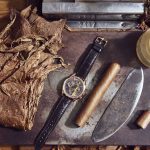Interviews
In Conversation With Aldo Magada
I think the crisis we are experiencing is older than most people perceive. Collectively, we need to find a way to interest people in watches again. The first thing is that products need to demonstrate value. I think, in general, over the years, we’ve increased our prices too much. To a level where there was no more value there. Remember anytime someone buys a watch, that means he is not buying something else. That something else could be an important holiday, a motorcycle or a car. But that something else might offer more perceived value to him. We have to win that fight. So we need to come back to value. The second thing is watches need to have real meaning to the modern customer. And in general, the entire industry has not done a good job of this because in the past years, it was too easy. And people thought that was the way it was, but it was not. They thought the good times would continue forever but they did not. So we have to recognize both of these things and work on it.
Tell me why products are not so compelling in general today and what we can do to change this…
OK, so for the watch to work today, it not only needs to have value and real content but also relevance. We’ve seen this work for brands like Hublot, who is succeeding because it connects with the modern consumer. How does Zenith reach beyond the traditional watch buyer to new consumers?
One thing that is very important is to give the customer a sense of ownership over a watch — he should feel as if that is his product. It was created specifically with him in mind. I really see the renaissance for traditional gentleman’s culture, which has been very well expressed by your magazine, The Rake, and it is a culture that really celebrates genuine, authentic things, and also things that allow a certain personalization, like a bespoke suit or a custom motorcycle. And our watches need to follow these customers in their worlds.
There is a nice parallel between the watchmaking and the cigar industries. The farmers in Jura, near Le Locle where you are based, started working on watches because the winters were so challenging and they had to find something else to do than farm. In some way, their terrain defined them. In Cuba, you also have a culture where the terrain defined its people. It is hot and humid, but it is the place that grows the best tobacco in the world. Would you agree?
Absolutely. Through the savoir faire and ingenuity of the Cuban people, a world-leading industry emerged for cigars, as it did for watches in Switzerland. When you have supposedly nothing, if your people are talented, they will make something out of what is apparently nothing.
The mythology of Cohiba is amazing. And we are very lucky to have our partnership with them. You know, I was in a museum in Belgrade and I looked through a show window, and in it was a genuine box of Cohiba cigars as a state gift from Castro to Tito. Cohiba has been a true part of global history. But what is so magical about Cohiba is the quality. It is ineffable. It is to cigars what Romanée-Conti is to wine. Both are able to extract and create something transcendent from something so basic like leaves or grapes. For Cohiba, there is a special fermentation process that breaks down the acidity and creates more complexity. It is like the grand cru of wine. And what is incredible is that the first time you taste a Cohiba, say a Siglo VI, even if you are not a connoisseur, you know you are tasting something special.
So it all started with an email from Jean-Claude Biver to Ricardo Guadalupe, Guy Sémon and myself, saying that he had a friend who knew the vice president of Habanos, based in Madrid, and that they were looking for some partnership with a watch brand for the 50th anniversary of a cigar brand; they didn’t at this point say it was Cohiba. Ricardo very wisely said that he already had a great partnership with Arturo Fuentes. So I voiced my interest. I met with Javier Terres, the man from Habanos; we had a lovely dinner where we smoked cigars and then he told me he was looking for a partner for the 50th anniversary of Cohiba. For me, it was incredible — this is THE flagship brand in the world of cigars. And in some ways, it was the perfectly compatible brand. Our manufacture was created by the founder of Zenith, Georges Favre-Jacot, to be the first integrated modern factory uniting all the disciplines for watchmaking under one roof. Cohiba was created by Castro to be the symbol of modern Cuba and the very best it could produce, which is why the famous label of the brand is so contemporary looking.
What I love about Cohiba is that they are the most innovative cigar brand in the world. They are constantly searching for new models, new shapes, new ways of rolling cigars. When they asked famed roller Norman Fernandez to create a new line of cigars for the brand’s 40th anniversary, and she created the Behike by adding a fourth type of leaf — the Medio Tiempo — to the filler of the cigar, this was a revolution. Try to find any Behike today on the market — they are sold out everywhere because they are just that good. Similarly, at Zenith, we try to respect tradition by innovating. When we created the El Primero in 1969 as the world’s first automatic integrated chronograph, and the first chronograph at 5Hz, it was a revolution. When we created the Christophe Colomb, a watch with a balance wheel that always stays horizontal, like in an ancient marine chronometer, it was a revolution. We are working on something for next year that is equally revolutionary.
We are working on this at the moment. That’s all I can say, Wei. But I can tell you that Jean-Claude wanted a movement that will allow us to produce a watch that is as affordable as possible. Perhaps not as cheap as the entry-level El Primero, but not far off either. A real value proposition.
Is it true TAG Heuer’s Guy Sémon is working on this?
Yes, in this project, we are definitely also using the capability of TAG Heuer and Guy Sémon.
TAG Heuer’s 1/100th-of-a-second chronographs use two oscillators: will it be the same here?
So we have one project with Guy that uses two barrels and two escapements. But we also have another project that uses just one barrel for the same result. But that will definitely not be ready for next year.
We are also working on something in our haute horlogerie [line], which is a new Christophe Colomb that is 70 percent smaller than the current one. This is probably at the limit of what a watchmaker can assemble. I think this is representative of what people want today. They still want ingenuity, they still want innovation, but in a more-discreet, classic package and in a watch that is meaningful to them.
Tell us about the incredible Cairelli CP-2 chronograph modeled after the CP-2 watch created for the Italian Airforce that you are relaunching? (Read about the Zenith Cairelli here)
The Cairelli will be launched in October this year and it fits exactly what I was talking about earlier in terms of having meaning to the modern consumer, in terms of making him feel like this watch was created for him. This watch, which is one of our most iconic from the ’60s, was originally created for the Aeronautica Militare Italiana. Two thousand and five hundred watches were produced but some of the pieces were sold to the civilian market by the famous retailer A. Cairelli in Rome. These are amongst the hottest and most sought after of our vintage watches and so, of course, we want to use this legacy to create a modern interpretation of the watch. To me, this watch speaks to the customer that likes vintage cars, or vintage motorcycles, or is part of the tailoring culture. It has that appeal. It has content, it has value and it has meaning and relevance.
Note: Mr. Aldo Magada’s portrait on the top of the article was taken by photographer, Nick Garcia.


















